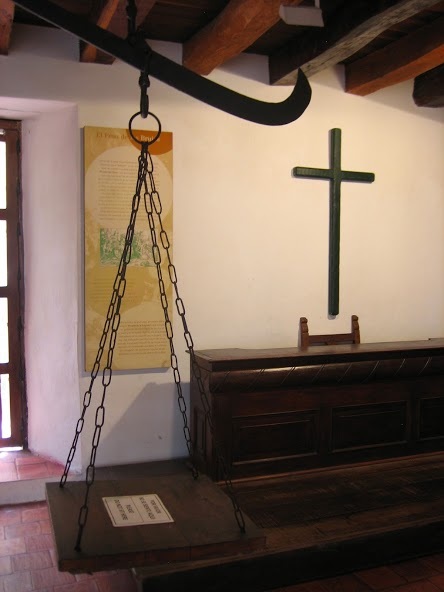On our third day in Cartagena, we visited a number of places in the old city including the Gold Museum and the church of San Pedro Claver. One place that stood out in a frightening way was the Palace of the Inquisition.
We had a wonderful guide named Victor who is a history professor at one of the local universities. He began our tour with a brief history of the Inquisition in Europe. In the old days, various monarchs throughout Europe used religion as a way to justify and maintain their control over their subjects. I remember learning about the Spanish Inquisition which started in the 15th century but there were various Inquisitions, the first of which began in the 12th century in France and spread across Europe. As the years passed and the Inquisition became more violent, it lost popularity among both commoners and princes. However, when Spain united through the marriage of Ferdinand and Isabella - both Catholic monarchs - they were in desperate need of money. At the time, many Jews lived in Spain and the King and Queen declared them to be the biggest enemy of the Catholic church because the Jews only considered Jesus Christ as another prophet, but denied him as their messiah. The Spanish Jews were also successful merchants & businessmen. So began the Spanish Inquisition. Thus the Jews were expelled (or worse) from the country and Ferdinand and Isabella claimed their property and wealth. The monarchs continued to use the Inquisition as an instrument of control and became extremely wealthy and powerful (Note: The Inquisition was not just against Jews but other religions including non-Catholic Christians).
When America was discovered, Spain was the most powerful empire in Europe. They brought the Inquisition to the new world in 3 locations - Cartagena being one of them. But in 1610, there were no other religions in Cartagena to persecute! Yes, there were natives but the Jesuits were there to convert them to Catholicism. So whom did they put on trial? Witches, of course.
Witches:
Our guide Victor told us that witchcraft did not originate in Colombia, it came from Europe. The Palace of the Inquisition was used for witch trials and forced confessions. It was not unlike what happened in Salem, MA however more gruesome and violent. Here is how it supposedly went down:
-Someone accuses someone else of being a witch and reports it to the Inquisition.
-The Inquisition hires someone to follow the alleged witch in order to gather proof of witchcraft. Proof could be as simple as having some dried leaves or grass in the house.
-Next the accused is arrested and weighed (see picture below). There was a magic number that a person should weigh back then, based upon a certain ratio to their height. If the accused's weight did not fall in that range, they were put on trial. For example, if a woman was too light, then she was definitely a witch because that meant she could fly (obviously!). If she was too heavy, then she was still likely a witch because she committed gluttony wich is one of the seven deadly sins. If she weighed the right amount, they would still put her on trial because they had a lot of proof from the accuser and investigator. So while it was the first step in the process, it was completely pointless. If you were accused, you were going to trial.
This is where it gets really gruesome. They forced the accused to confess using unimaginable instruments. After seeing these devices, it's clear that nobody could stand the pain inflicted by these methods for more than a few seconds which is why most immediately confessed and accused others of being witches. Why did they torture these people? They thought they would become closer to God through suffering. Here are some of the devices they used:
So how do weddings fit into all this?
Well behind the Palace is a courtyard typical of most colonial Spanish homes. In this courtyard they have a guillotine and a gallows - both of which were NOT used at this Palace but were put in the museum courtyard for show. They were not used during the Inquisition at this Palace because the Inquisition did not execute people - they only convicted people as witches. The police were responsible for execution. If the accused died during confession (ahem torture) it was deemed an accident.
Anyway back to weddings. Victor told us that this courtyard was a popular place for weddings these days. He said that the bride and groom take pictures on the fake gallows and with the guillotine. I couldn't beleive it! I Googled it and sure enough there are pictures!




 RSS Feed
RSS Feed
